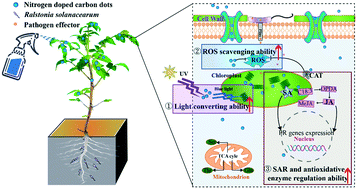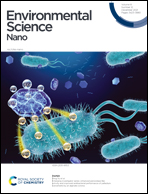Nitrogen-doped carbon dots alleviate the damage from tomato bacterial wilt syndrome: systemic acquired resistance activation and reactive oxygen species scavenging†
Abstract
Plant disease seriously threatens the global food security. However, an effective and sustainable control strategy is lacking. In this study, foliar application of 10 mg L−1 nitrogen doped carbon dots (N-CDs) suppressed bacterial wilt in tomatoes, statistically decreased disease severity by 71.19%, and increased the fresh biomass of tomato shoot by 55.86%. The disease control efficacy of N-CDs was 1.56-fold greater than that of pure CDs (P-CDs). Mechanistically, 1) nitrogen doping enhanced the reactive oxygen species (ROS) scavenging ability of P-CDs, and then exhibited higher oxidative stress alleviation in tomatoes; 2) N-CDs activated the salicylic acid and jasmonic acid dependent systemic acquired resistance (SAR) in tomatoes, with subsequent inhibition of in vivo pathogen growth; 3) N-CDs activated the antioxidative enzyme activity in tomatoes, and then reduced the pathogen induced oxidative stress. Polyacrylic acid modification eliminated the disease control ability of N-CDs because the modification decreased the direct physiochemical process (e.g., ROS scavenging) and indirect resistance activation (e.g., SAR activation) of N-CDs in tomatoes. Metabolomics analysis suggested that N-CDs also significantly promoted the tricarboxylic acid cycle and fatty acid synthesis in tomatoes. The findings demonstrate the important role of N-CDs in promoting disease suppression for sustainable agriculture.



 Please wait while we load your content...
Please wait while we load your content...